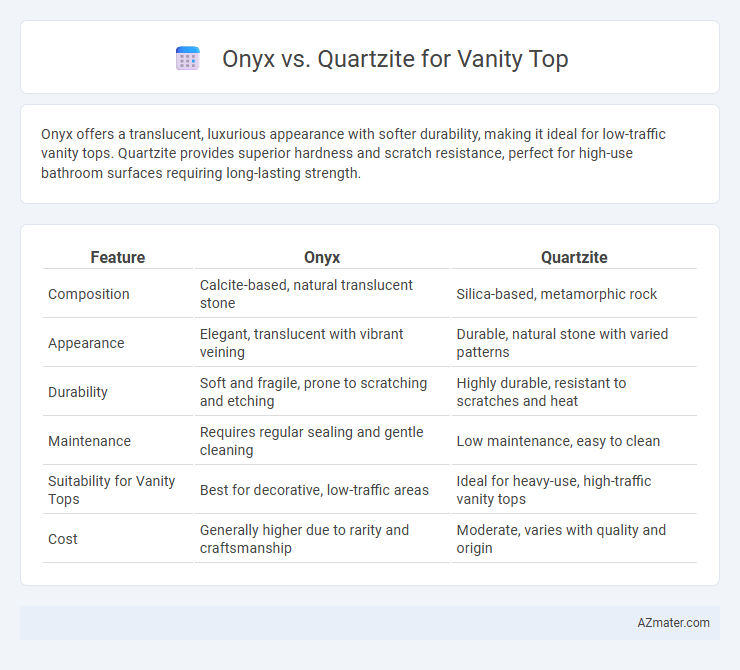Onyx offers a translucent, luxurious appearance with softer durability, making it ideal for low-traffic vanity tops. Quartzite provides superior hardness and scratch resistance, perfect for high-use bathroom surfaces requiring long-lasting strength.
Table of Comparison
| Feature | Onyx | Quartzite |
|---|---|---|
| Composition | Calcite-based, natural translucent stone | Silica-based, metamorphic rock |
| Appearance | Elegant, translucent with vibrant veining | Durable, natural stone with varied patterns |
| Durability | Soft and fragile, prone to scratching and etching | Highly durable, resistant to scratches and heat |
| Maintenance | Requires regular sealing and gentle cleaning | Low maintenance, easy to clean |
| Suitability for Vanity Tops | Best for decorative, low-traffic areas | Ideal for heavy-use, high-traffic vanity tops |
| Cost | Generally higher due to rarity and craftsmanship | Moderate, varies with quality and origin |
Introduction to Onyx and Quartzite Vanity Tops
Onyx vanity tops feature translucent, layered patterns with a luxurious appearance and require careful maintenance due to their softness and sensitivity to acids. Quartzite vanity tops offer high durability, heat resistance, and a natural stone aesthetic resembling marble but with superior hardness, making them ideal for bathroom applications. Choosing between onyx and quartzite depends on balancing the desire for striking beauty with practical durability in vanity surfaces.
Aesthetic Appeal: Onyx vs Quartzite
Onyx offers a stunning, translucent appearance with unique veining and vibrant color variations that create a luxurious and dramatic vanity top, perfect for high-end designs. Quartzite provides a natural stone look with subtle, consistent patterns and a matte to glossy finish, appealing to those who prefer understated elegance and durability. The choice between onyx and quartzite for aesthetic appeal hinges on whether you desire bold visual impact or timeless, classic beauty in your bathroom vanity.
Durability and Strength Comparison
Quartzite outperforms onyx in durability and strength, making it a superior choice for vanity tops subjected to daily wear and tear. Quartzite's high hardness rating of 7 on the Mohs scale provides excellent resistance to scratches, heat, and stains compared to onyx, which ranks between 3 and 4 and is prone to etching and chipping. The dense, non-porous structure of quartzite also offers better longevity and requires less maintenance than the softer, more fragile onyx.
Maintenance Requirements
Onyx vanity tops require frequent sealing to prevent staining and etching due to their porous nature and softer surface, making maintenance more demanding compared to quartzite. Quartzite is highly durable, heat-resistant, and less prone to scratches, requiring only periodic sealing and gentle cleaning to maintain its appearance. Choosing quartzite over onyx for a vanity top offers a balance of low-maintenance durability and elegant natural stone aesthetics.
Resistance to Stains and Scratches
Onyx vanity tops offer a unique, translucent beauty but tend to be softer and more susceptible to scratches and stains due to their calcareous composition. Quartzite, composed primarily of quartz grains, provides superior durability with high resistance to scratches and acid stains, making it more suitable for high-traffic bathroom areas. For homeowners prioritizing longevity and low maintenance, quartzite stands out as the optimal choice for vanity tops.
Cost and Price Differences
Onyx vanity tops typically range from $70 to $150 per square foot, making them a more expensive choice compared to quartzite, which averages between $50 and $100 per square foot. The higher price of onyx stems from its rarity and delicate nature, requiring specialized installation and maintenance. Quartzite offers a more affordable, durable option with cost benefits for homeowners seeking longevity without compromising on natural stone beauty.
Installation Considerations
Onyx vanity tops require careful handling during installation due to their softness and vulnerability to scratching and chipping, necessitating professional expertise and precise support frameworks. Quartzite, being harder and more durable, allows for easier installation with standard tools and provides better resistance to heat and impact, reducing long-term maintenance concerns. Proper sealing is critical for both materials to prevent staining, but quartzite generally demands less frequent resealing compared to the more porous onyx.
Pros and Cons of Onyx Vanity Tops
Onyx vanity tops offer unique translucency and vibrant color variations, creating a luxurious and eye-catching bathroom centerpiece. However, onyx is softer and more porous than quartzite, making it prone to scratches, etching, and staining, requiring regular sealing and careful maintenance. Quartzite provides superior durability and resistance to heat and chemicals, but lacks the striking translucence that defines onyx surfaces.
Pros and Cons of Quartzite Vanity Tops
Quartzite vanity tops offer exceptional durability and scratch resistance, making them ideal for high-traffic bathroom areas, while their natural quartz and feldspar composition provides a unique, luxurious appearance similar to marble but with enhanced strength. However, quartzite requires regular sealing to prevent potential staining and etching from acidic substances, and its installation costs tend to be higher due to the stone's hardness and weight. In comparison to onyx, quartzite is more heat and impact resistant but lacks the translucent, glowing quality that makes onyx a distinctive choice for vanity tops.
Which is Best for Your Bathroom: Onyx or Quartzite?
Onyx offers a luxurious, translucent appearance with unique veining, making it ideal for a dramatic bathroom vanity top; however, it is softer and more prone to scratches and stains than quartzite. Quartzite is a highly durable natural stone resistant to heat, scratches, and etching, providing a long-lasting, low-maintenance surface suitable for busy bathrooms. Choosing between onyx and quartzite depends on prioritizing aesthetic appeal with delicate care or opting for strength and practicality in your bathroom vanity top.

Infographic: Onyx vs Quartzite for Vanity Top
 azmater.com
azmater.com